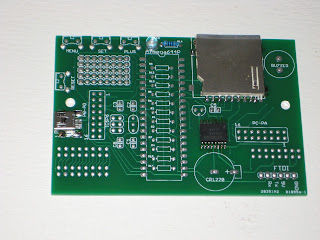StefanK from Germany put together this a nice assembly guide for Wise Clock 4. Thanks Stefan!
Updated March 25, 2012
Here is a troubleshooting guide.
Updated March 10, 2012
Follow these same instructions to assemble Wise Clock 4 as well.
There are a few minor differences:
- the optional power LED and resistor (both SMD) are not included; so skip step 2;
- there are 2 extra resistors (R17 and R18), both 10k, on the right side of the processor;
- the 470uF electrolytic capacitor (C4) must be placed with the minus terminal (marked with a band) towards the bottom of the board (this capacitor is useful only if an XBee/WiFi radio module is present);
- the reset button is not used anymore;
- the voltage regulator (78L33, through hole) was replaced with MIC5219 SMD, which is already soldered on the board.
Updated May 16, 2011
Thanks Scott for contributing this PDF version of the assembling instructions.
The Wise Clock 3 PCB comes with the SD card socket and the RTC chip already soldered, and looking like this.
Follow these steps:
1. Place and solder the miniB USB connector; actually, since this connector is only used for power, only the two extreme pins (1 and 5) must be soldered; the middle three can be left untouched. Make sure the connector is solidly anchored to the board through the 4 lateral holding pads; there will be lots of mechanical tension when the power cable is plugged/unplugged.
2. Solder the 100 ohm resistor (brown black brown), indicated on the PCB as R14, then the LED, paying attention to its orientation. The shorter pin, the cathode, goes into the left (as you look at the PCB as in the image below) hole. At this point, by plugging in the power cable, the LED should light up.
3. Solder resistors R5, R6, and R7, all 4K7 (yellow purple black brown brown), as shown in the next photo.
4. Solder the rest of the resistors, all 10K, as shown in the photo below.
Note that there are 9 resistors of 10K value (brown black orange): R1, R2, R3, R4, R9, R10, R11, R12, R13.
5. Solder the 40-pin socket, then the battery holder and the 4 buttons, see photo below.
6. Solder the 3 decoupling capacitors (100nF, labeled "104"): C3, C5, C8. Then continue with soldering the two smaller ones C1, C2 (both 22pF).
7. Insert the crystal (the small, metallic, oval cylinder, with 2 pins, labelled "16.000" on its top) in its position on the left side of the microcontroller socket, indicated by an oval (see the above image). Orientation is not important for the crystal.
Then insert the 3V3 voltage regulator (black, 3-pinned, semi-cylindric part labeled "L78L33ACZ") as indicated on the silkscreen by the half-cylinder on the right side of the microcontroller socket (its orientation is very important), then solder in place.
Next solder the 6-pin male header, and then the piezoelectric buzzer (its orientation is not important).
Look at the photo of the final assembled board (two photos down) before soldering, to make sure you have these parts placed correctly.
8. Insert the two 16-pin female headers on the back of the board (opposite to the parts side) and solder them on the top (parts) side.
To get the best alignment possible on these headers, Justin (thanks) suggested to insert the 16-pin headers into their sockets (in the display), then solder the board on top. (This is similar to the way the male headers are soldered on an Arduino-shield.)
9. It is time to add now the preprogrammed ATmega644P microcontroller. Before inserting it in the socket, slightly bend both sets of its pins on a table, so that they become parallel. Position the chip carefully on top of the socket, paying attention to its orientation: pin 1, marked with an arrow (triangle), must be close to the upper side of the board. Push the chip firmly into the socket.
Next insert the coin battery in the battery holder.
The assembled board should look like in the photo below.
10. Plug the Wise Clock 3 board into the 3216 LED display from Sure Electronics (not supplied in the Wise Clock 3 kit).
11. Copy the files (provided in the zip) onto the SD card, formatted FAT16, then insert the SD card in the socket.
12. Power the board with a miniB USB cable. You made it! Congratulations! Next, set up the clock (date and time) from the buttons. Then chose your favorite clock mode and enjoy.
Related posts:






















Good tutorial! Had my Wise CLock 3 up and running in 30 minutes.
ReplyDelete